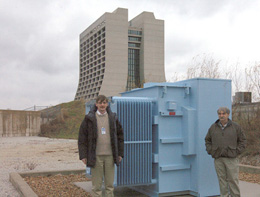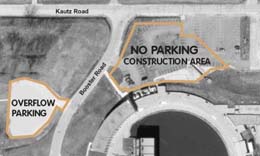 |
|
Cool Idea Test area for muon cooling recycles equipment for a new concept by Kurt Riesselmann It takes great ideas to make technological advances. And it takes experimental setups to test great ideas. In the past one hundred years physicists have relied mostly on beams of electrons, protons and their corresponding antiparticles to advance our knowledge of the universe and its building blocks. Now physicists think that it’s time to introduce a new type of charged particle to the bag of particle projectiles: the muon, a short-lived particle two hundred times heavier than its cousin, the electron. The 130 members of the Neutrino Factory and Muon Collider collaboration have worked for about five years on the design of very intense sources for producing muons, suitable for subsequent acceleration to high energies.
If the design of such machines succeeds, scientists may some day turn to muons as a new surgical tool to probe deep into the structure of matter. In addition, experimenters can use muons to produce very intense beams of neutrinos, another particle that is causing much excitement amongst particle physicists. At present, the Muon collaboration is getting ready to test its ideas and designs. Two small new buildings, located at the southeastern end of Fermilab’s Linear Accelerator, will host the infrastructure for the new lab for accelerator R & D. The cost of the new construction, called the MuCool project, is about two million dollars. It is paid by DOE funds provided directly to the Muon collaboration, which primarily consists of particle-and accelerator physicists from U.S.laboratories and universities, but also has some participation from institutions in Japan and Europe. Much of the equipment that will go into the new buildings is either recycled (an old cryogenic plant at Fermilab will be moved to the new location), donated (a transformer from Northwestern University has already arrived), already exists in the adjacent Linac (radiofrequency tubes and klystrons)or will be built by collaborating institutions (an RF cavity, for example, will come from Lawrence Berkeley Laboratory). “The power source for the RF cavity would have been the most expensive piece,” said Fermilab physicist Steve Geer, cospokesperson of the Muon collaboration.“The Linac has two spare stations that we can use without affecting its operations and maintenance requirements.” When complete in 2004 the MuCool laboratory will offer radiofrequency power of 200 and 800 megahertz, and cryogenic equipment to provide cooling with liquid helium.
“It will have all the things that you need for accelerator R& D,” said physicist Milorad Popovic, who is overseeing the MuCool construction at Fermilab. “The collaboration spends two million dollars and gets a ten-million-dollar test area.” The Muon collaboration, which includes ten Fermilab physicists, will use the MuCool lab to test how to pack a large number of muons tightly together to create a narrow, high-density beam. “A muon beam would initially be large, like the size of a basketball,” said Popovic.“But such a big, fat beam wouldn’t fit into an accelerator.” To solve this problem, the Muon collaboration has developed a design that relies on two components: liquid hydrogen absorbers, which reduce the spread of the beam in transverse direction, and radiofrequency cavities, which reaccelerate the muons in longitudinal (forward) direction. Theoretically, an alternating series of absorbers and cavities is the right idea to tame a large, diffuse group of muons, transforming it into a densely packed muon train moving at high speed. Practically, the idea needs to be put to the test. “Demonstrating the beam-cooling capabilities of the hydrogen absorbers and RF cavities is the critical item,” said Steve Geer.“Developing these components is the critical path before you can do more extensive tests. We need to start engineering tests without beam. If successful,we hope to use a muon beam line at the Rutherford laboratory [in the U.K.] to test this system. Rutherford has an eight hundred MeV proton accelerator that would create one hundred to two hundred MeV muons.” To secure funding for its R & D program, the Muon collaboration is breaking new ground. Traditionally, R& D for accelerators has taken place at national laboratories, with little participation from university scientists. Tight budgets at accelerator laboratories, however, have led project leaders to look for more funding and manpower from universities. Members of the Muon collaboration receive money from the Department of Energy, the National Science Foundation, and some modest funds from Japan. Individual institutions have obtained additional funding. The five member institutions of the Illinois Consortium for Accelerator Research, for example, have gotten money from the state of Illinois. “We are doing this on a shoestring,” said Geer. “The biggest asset we have is the enthusiasm of the people.”
ON THE WEB: |

